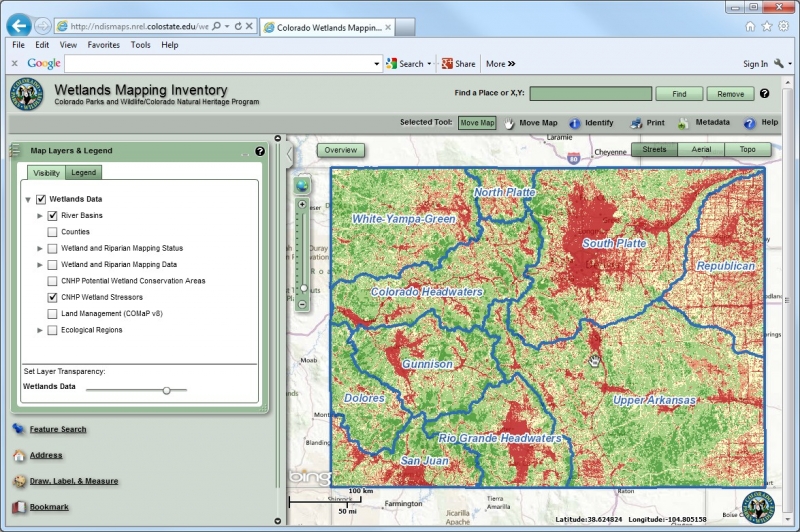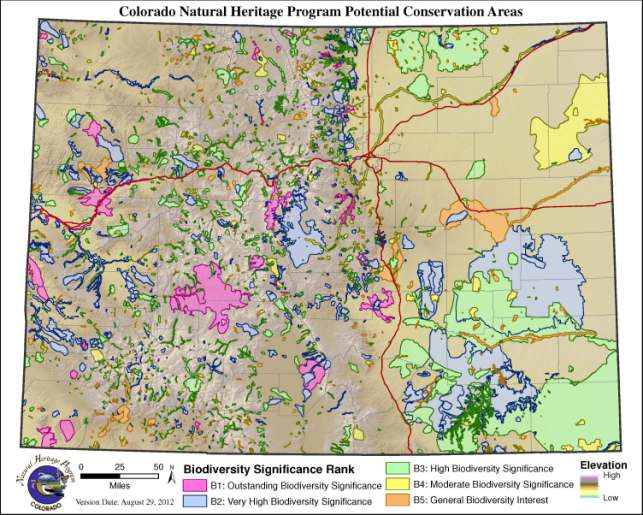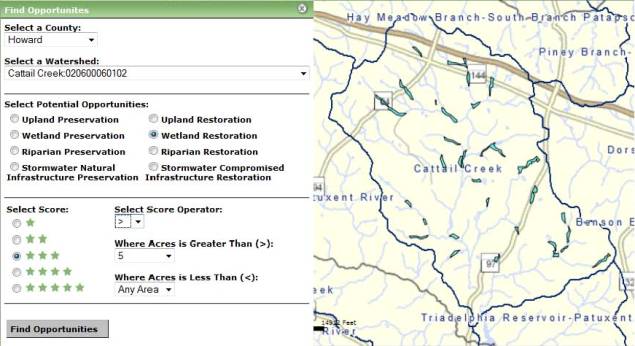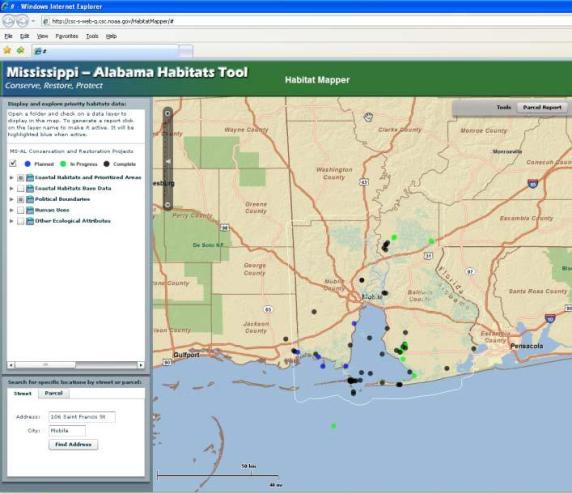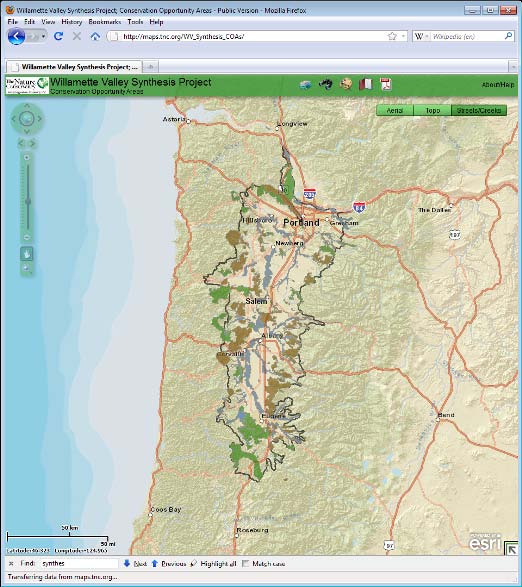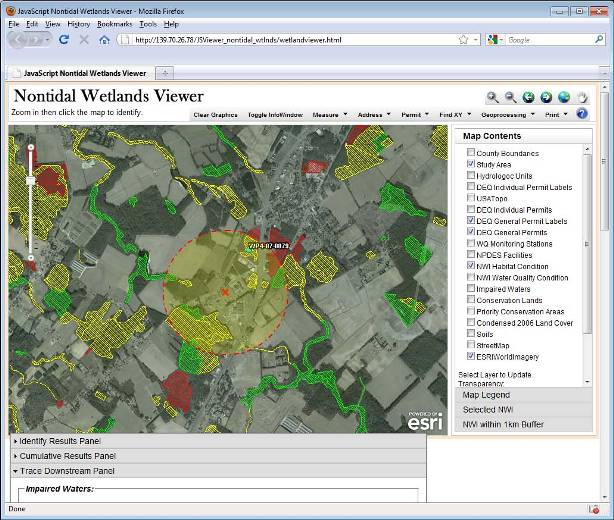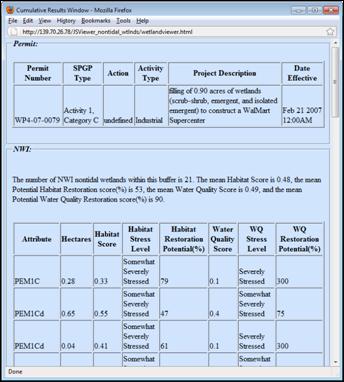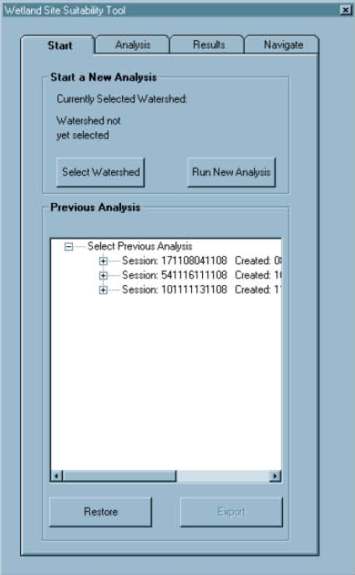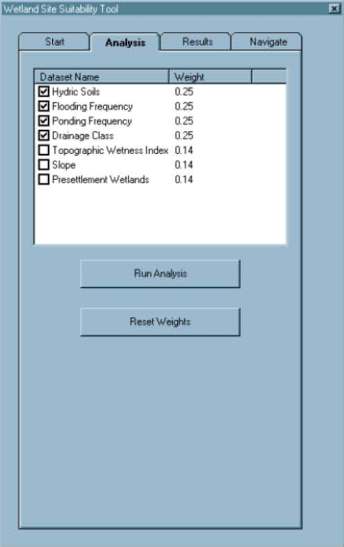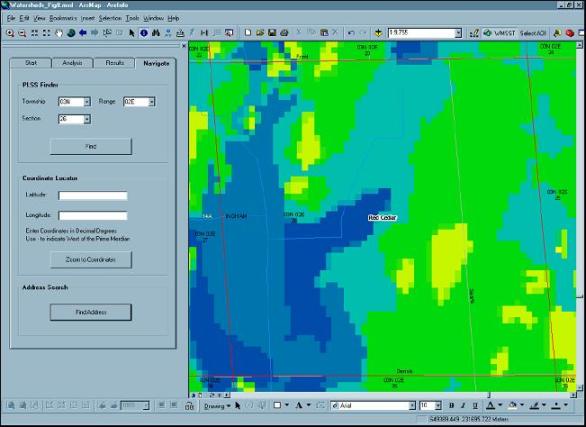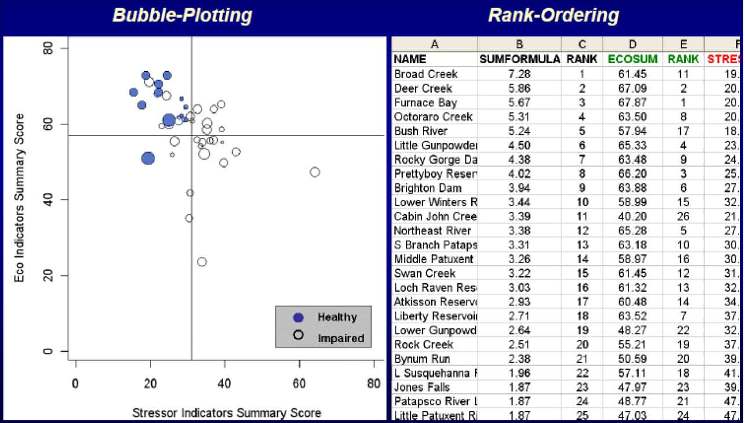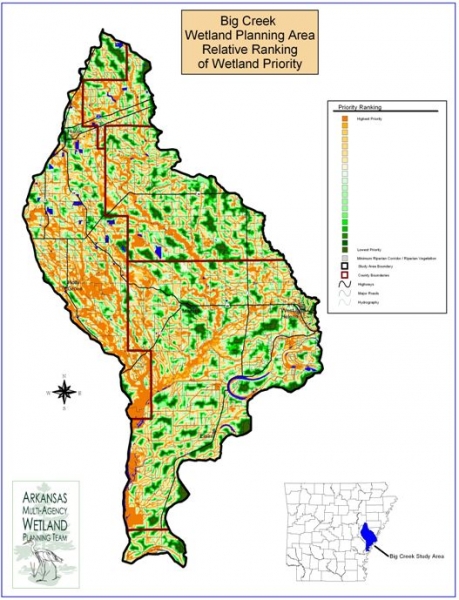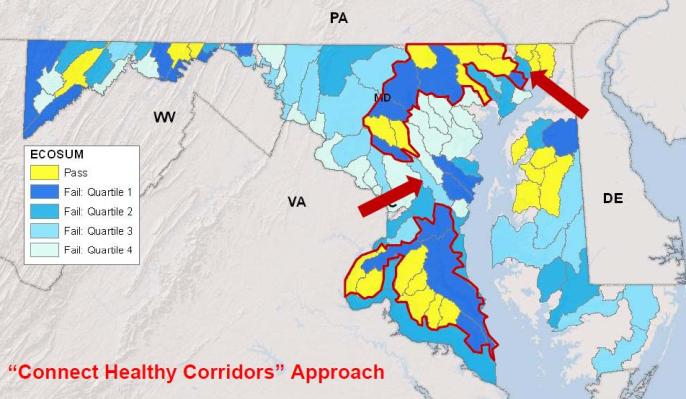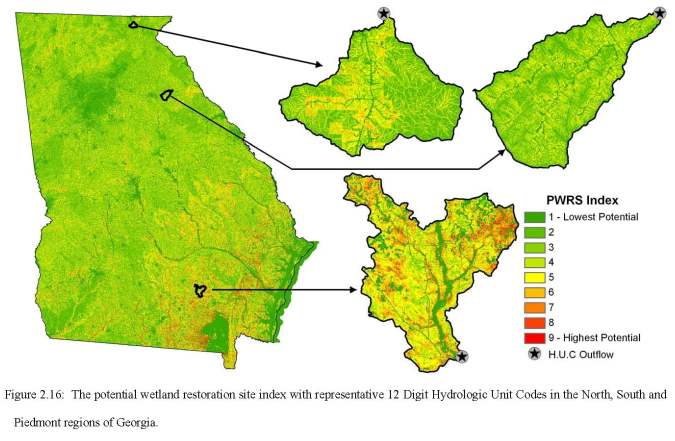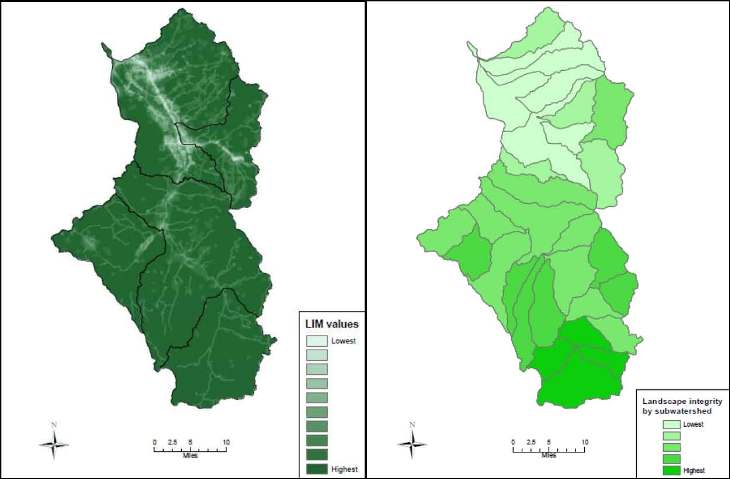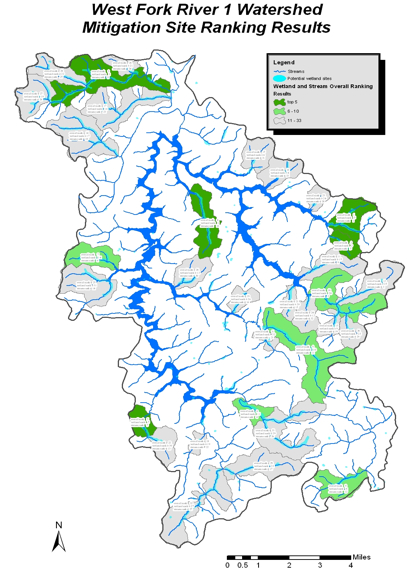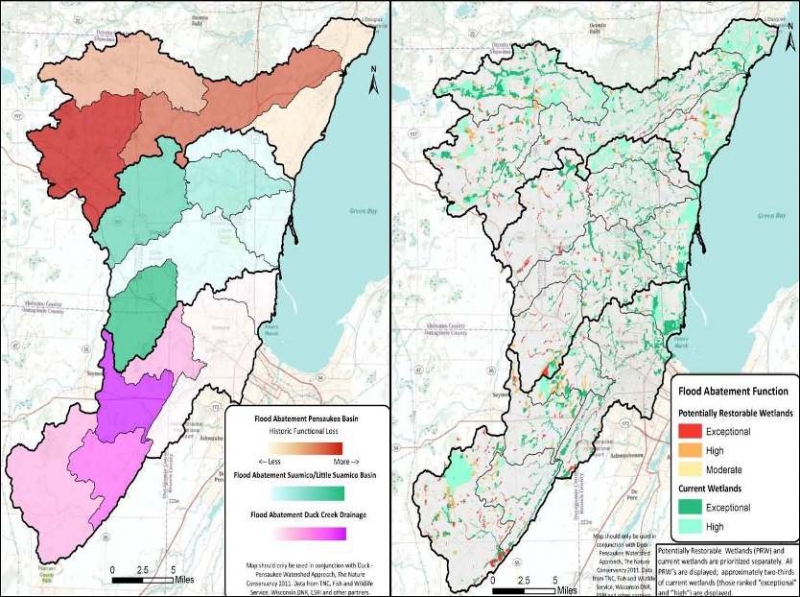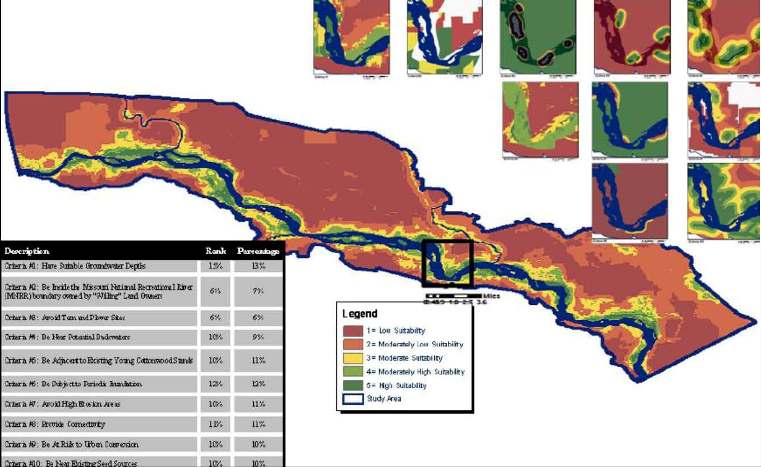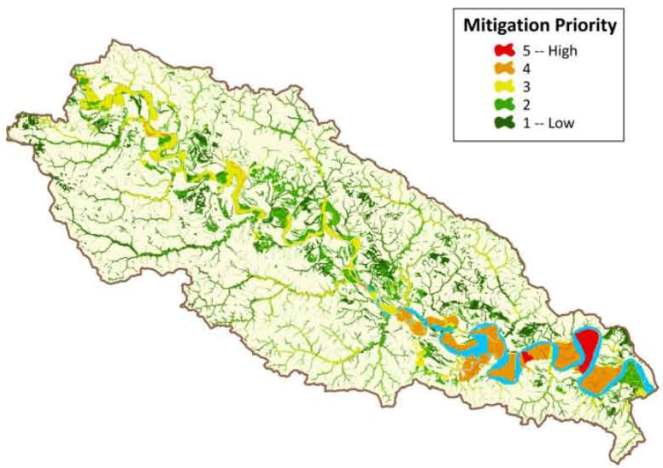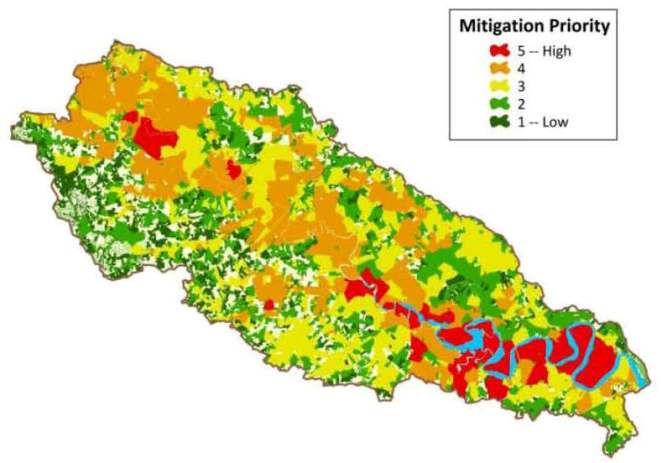Prioritization products
Wetland Prioritization Study Main Page
Interactive web-based maps
- Colorado Natural Heritage Program
- Maryland Watershed Resource Registry
- NOAA Habitat Priority Planner Mississippi-Alabama Habitats Tool
- TNC-ELI Duck-Pensaukee Watershed Approach Pilot
- TNC Willamette Basin Synthesis Project
- VIMS Wetland Condition Assessment Tool
Software tools
- Michigan Tech Research Institute
Tables/graphs
- EPA Recovery Potential Screening
- Virginia Department of Conservation and Recreation
Instructional materials for prioritization tool application
- EPA Recovery Potential Screening
- Virginia Department of Conservation and Recreation
Static maps
- Arkansas Multi-Agency Wetland Planning Tool
- Caltrans Regional Advance Mitigation Planning
- EPA Recovery Potential Screening
- Kaufmann-Axelrod and Steinberg (2007)
- Kramer et al. (2012)
- Montana Natural Heritage Program
- North Carolina Ecosystem Enhancement Program
- Strager et al. (2011)
- TNC Aquatic Ecoregional Assessment
- TNC-ELI Duck-Pensaukee Watershed Approach Pilot
- UMass Amherst Conservation Assessment and Prioritization System
- USACE Sunrise River Watershed-Based Mitigation Pilot
- Virginia Department of Conservation and Recreation
- Washington State Department of Ecology
Interactive web-based maps
Colorado Natural Heritage Program (CNHP): CNHP's map of wetland landscape integrity can be visualized using an online interactive map developed by CNHP in collaboration with Colorado Parks and Wildlife (CPW), which can be accessed at: https://csurams.maps.arcgis.com/apps/webappviewer/index.html?id=a8e43760cb934a5084e89e46922580cc.
In addition to visualizing the Landscape Integrity Model (LIM) stressor map, users of the interactive tool can overlay boundary data for river basins, counties, and ecoregions as well as other features of interest (e.g., a variety of wetland and riparian GIS datasets). Users can also view CNHP's map of Priority Conservation Areas, which in the future will be selected using a targeted assessment process guided by the LIM tool. A variety of static maps and GIS data are available for download from CNHP's website at: http://www.cnhp.colostate.edu/download/gis.asp.
Maryland Watershed Resource Registry (WRR): Users can query each of the eight suitability maps on WRR's website (http://www.watershedresourcesregistry.com) by specifying a 12-digit subwatershed, a county, a size criterion (e.g., ›5 acres), and a rating criterion (e.g., higher than three stars) to interactively highlight wetlands that meet those criteria.
NOAA Habitat Priority Planner Mississippi-Alabama Habitats Tool:1 The habitat prioritization maps are made available as part of on online, interactive map. In addition to visualizing priority habitat area, users can also overlay maps identifying the locations of planned, existing, and in-progress restoration and conservation activities throughout the estuary. Furthermore, users can enter addresses or parcel numbers to examine priority habitats that specific lands support and can identify locations of existing wetland restoration and conservation efforts. The Habitat Mapper is accessible at http://habitats.disl.org/ .
The Nature Conservancy (TNC) and Environmental Law Institute (ELI) Duck-Pensaukee Watershed Approach Pilot (DPWAP): Output maps for each tool applied as part of the TNC-ELI DPWAP, including the Flood Abatement Tool, Surface Water Supply Tool, Water Quality Tool, Carbon Storage Tool, Shoreline Protection Tool, Fish Habitat Tool, and Wildlife Habitat Tool are provided online via an interactive mapping tool ( http://maps.tnc.org/DuckPenTool/).
TNC Willamette Basin Synthesis Project: The Willamette Valley Synthesis Map can be visualized using an online interactive mapping tool available at: http://maps.tnc.org/WV_Synthesis_COAs/. This online tool, which uses basic Google maps, has helped TNC to be highly effective in communicating priority areas identified by the Willamette Valley Synthesis Map to the public. In contrast, TNC typically documents the Conservation Opportunity Areas (COAs) it identifies using CDs or in hard-bound reports, formats that are much less accessible for the public to access.
The Willamette Valley Synthesis Project identified a Union Portfolio of Conservation Opportunity Areas for potential restoration and conservation projects (shown below). Both terrestrial (green and brown) and freshwater (blue, light blue, and gray) sites are represented in the portfolio.
Using the Willamette Valley Synthesis Project (WVSP) online mapping tool, members of the public can draw recommended additions or changes to COAs identified in TNC's Union Portfolio (shown below). Members of the public can then print changes as a PDF for submission to TNC for incorporation into the Union Portfolio.
Virginia Institute of Marine Sciences (VIMS) Wetland Condition Assessment Tool: VIMS will make results from its Wetland Condition Assessment Tool available as part of its Nontidal Wetlands Viewer web tool, which will allow users to study individual wetlands throughout Virginia using a variety of map overlay and geoprocessing tools.
Virginia Institute of Marine Sciences (VIMS) Wetland Condition Assessment Tool: VIMS will make results from its Wetland Condition Assessment Tool available as part of its Nontidal Wetlands Viewer web tool, which will allow users to study individual wetlands throughout Virginia using a variety of map overlay and geoprocessing tools.
For instance, users will be able to overlay impaired waters, priority conservation areas, and sites that have received VDEQ permits, among other features, over NWI wetland maps. In addition, one geoprocessing tool will allow users to select a point on the landscape and observe cumulative effects to wetland habitat and water quality within 1 kilometer of that point:
Another geoprocessing option will allow users to trace the downstream flow path from a point and visualize the contributing watershed to a point. Availability of the VIMS WetCAT online mapping tool is forthcoming.
Software tools
Michigan Tech Research Institute (MTRI):2,3 To apply the Wetland Mitigation Site Suitability Tool (WMSST) to identify potential wetland restoration sites, MTRI loads eight input layers into ArcGIS on a field-ready notebook computer that is connected to a GPS unit and on which ArcGIS and the WMSST dockable window interface have been installed. MTRI distributes the WMSST for installation on field computers as a Microsoft Windows dynamic-link library.
In ArcGIS, users select the watershed or ecoregion in which to identify priorities using a dockable window interface that MTRI programmed for ArcGIS. Users then indicate whether the model should exclude any of the eight layers from the analysis and set weightings for each of the included layers. The user then runs the WMSST to calculate a weighted average of all weighted layers included in the analysis to obtain final site suitability scores for each pixel. In the output map, high scores indicate the most suitable locations for wetland restoration or creation. In addition, the GPS unit shows users their current position within the WMSST and facilitates real-time data modeling, navigation, visualization, and decision-support capabilities.1 Within the WMSST, users visualize the site suitability output map together with several other data layers to obtain further information about the suitability of potential wetland mitigation sites. These additional visualization layers include:
- Watershed boundaries from the Michigan Department of Environmental Quality.
- Regional landscape ecosystems data from the Michigan Natural Features Inventory.
- Michigan Geographic Features data for roads, hydrography, cities and villages, counties, and Public Land Survey Sections (PLSSs).
- Existing wetland boundaries data from the United States Fish and Wildlife Service (FWS) National Wetland Inventory (NWI).
- Digital Elevation Model (DEM) data from the United States Geographic Survey (USGS).
- Cropland data from 2007 from the United States Department of Agriculture (USDA).
- Aerial photography data from 1998-2007.
Users of the WMSST complete an analysis by using a sequence of four tab controls:
1. Under the "Start" tab, users specify the extent of the analysis as either watershed or ecoregion boundaries. Users can also retrieve previously saved analyses, allowing modeling tasks to be reviewed later as part of the project planning process (see below).
2. Under the "Analysis" tab, users select the weights to be applied to calculate the weighted mean for input layers in the WMSST. In addition, checkboxes allow users to indicate which layers to include or exclude in the analysis (see below). Once weightings and layers to be included are set, the user runs the analysis.
3. After the site suitability map is displayed, users may use the "Results" tab to save the results of the analysis, print the results, create a new analysis, or navigate to a finer scale for a more detailed analysis of the results.
4. Under the "Navigate" tab, users can easily navigate to study area sites using PLSS Township, Range, and Section numbers (see below), which are also used to reference project areas under Michigan Department of Transportation (MDOT) project standards. This feature allows MDOT Environmental Section users to quickly view project areas within suitability model results. Users can also specify the latitude/longitude or address of the project area.
In addition, MTRI has made technical reports for the WMSST available to the public from http://www.tarut.org/ . Among other deliverables, these reports include a technical and training manual that describes how the WMSST works, how to install the WMSST software, and how to prepare, conduct and interpret a modeling session. Another report summarizes results of a validation study that compared WMSST assessments of feasibility of restoration/creation with those obtained based on an MDOT assessment of field monitoring data.
Tables/graphs
EPA Recovery Potential Screening (RPS):4 EPA supports Recovery Potential Screening through public availability of a tools and resources website (www.epa.gov/recoverypotential) that contains step-by-step screening directions, indicator and data source reference materials, and downloadable tools. The tools include an "auto-scoring spreadsheet," in which users can enter the indicator values for each hydrologic unit (e.g., from a spatial database file) and press "calculate" to obtain recovery potential scores across units. This tool automates calculation of the Ecological Capacity, Stressor Exposure, Social Context, and Recovery Potential Integrated indices, rank-orders each index, and formats data for further use by other RPS tools in bubble plotting and mapping applications explained below.
The user visualizes recovery potential scores using bubble plots that graph ecological index against stressor index with dot size related to social index score (below). The recovery potential screening tool generates rank-ordered scores for ecological, stressor, and social context indicators for each HUC-12 watershed (right). These may be used to visualize restorability differences among impaired watersheds using bubble plots (left), which may also display reference healthy watersheds as determined from field-based assessment data.
Virginia Department of Conservation and Recreation (VDCR):5 The VDCR GIS Model produces tabular products that provide scores for each wetland and parcel. Attribute tables from VDCR spatial products, such as that shown below, provided values for wetland likelihood overlay, mitigation value, and composite prioritization scores. Tabular outputs can be altered (i.e. manipulation of weights assigned to prioritization factors) by a desktop GIS user to display varying map outputs with emphasis on different mitigation values.
Instructional materials for prioritization tool application
EPA Recovery Potential Screening: EPA includes step-by-step instructions for applying its RPS methodology on its website at: http://water.epa.gov/lawsregs/lawsguidance/cwa/tmdl/recovery/methodology.cfm#screeningexample.
Virginia Department of Conservation and Recreation (VDCR):6 To support potential efforts to repeat its prioritization analysis for different areas, as part of its technical report VDCR provides detailed step-by-step instructions that describe how its analysis was carried out in ArcGIS.
Static maps
Arkansas Multi-Agency Wetland Planning Tool (MAWPT): Maps resulting from the MAWPT prioritization efforts are available in reports produced for each Wetland Planning Area (WPA). An example of a priorities map, for the Big Creek WPA, is provided below:
Caltrans Regional Advance Mitigation Planning (RAMP):7 RAMP applies MARXAN to identify priority parcels for mitigation of agency infrastructure projects. In the below map, dark brown colored parcels represent those most likely to meet Caltrans' mitigation need, while red parcels are "best" solutions that meet mitigation needs at low cost.
EPA Recovery Potential Screening: Mapping scores from the EPA RPS Ecologial Capacity Tool, Stressor Exposure Tool, and Social Context Assessment may also be used to visualize spatial relationships among HUC-12s. For example, the map shown below for Maryland, in which HUC-12s are color-coded by ecological indicator score, can be used to identify HUC-12s in which restoration may be most effective for building larger healthy watershed patch size and establishing healthy corridors by targeting impaired but restorable watersheds in key locations (indicated by the red arrows).
Kaufmann-Axelrod and Steinberg (2007): Tabular data for the top ten priority potential restoration sites in the Coos estuary watershed and map output for the top ten percent of priority potential restoration sites are available in Kauffman-Axelrod and Steinberg (2010). In addition, tabular rankings, parameter values, static maps, and geodatabase outputs, along with any other criteria and metadata, produced for this tidal wetlands restoration prioritization are available upon request.
Kramer et al. (2012):8,9 Output maps for each of the Kramer et al. (2012) landscape analysis tools, including the Potential Wetland Banking Site Index (PWBSI) output shown below, are available as static maps and GIS data for the state of Georgia. The Georgia Environmental Protection Division (GAEPD) is also currently in the process of developing an online map viewer with which to view the outputs, although GAEPD does not currently know when it will be completed or whether they will make it available to the public.
Montana Natural Heritage Program (MTNHP):10 The Landscape Integrity Model (LIM) has been described in MTNHP publications and the raster layer can be made available to interested parties on request. To support prioritization of wetland restoration or conservation, users may apply the model to visualize individual pixel ratings throughout the landscape or average MTLIM scores for subwatersheds and identify large contiguous areas where high integrity wetlands are likely to be found (see below). In some cases, users may also combine scores for individual wetlands with other metrics used in the MTNHP's landscape prioritization, rapid assessment, and intensive assessment protocol (e.g., evidence of grazing within 1km) that may increase the accuracy with which the MTLIM predicts wetland condition.
North Carolina Ecosystem Enhancement Program: Prioritized project sites identified as part of NCEEP's Local Watershed Plans are listed in a Project Atlas, which includes a large-scale map of all projects in addition to site-specific maps and information for at least the highest-ranking projects. The map below shows restoration/enhancement sites determined to provide high potential for functional benefits in the Bald Creek watershed. Prioritization maps can be accessed in each LWP, which can be downloaded from: http://www.nceep.net/services/lwps/.
Strager et al. (2011): In the West Fork River watershed of West Virginia, Strager et al.'s analysis identified potential wetland and stream mitigation sites (all shaded areas below). In the rapid assessment part of the analysis, each of these areas was scored, weighted, and ranked based on a variety of criteria. Highest ranked sites are indicated by the most darkly shaded areas below.
TNC Aquatic Ecoregional Assessment: The prioritization results of TNC's ecoregional assessments are made available to TNC partners as static maps and GIS data and are documented in annual reports that TNC provides to public agencies. These reports identify specific aquatic resource restoration and conservation projects that the Virginia Aquatic Resource Trust Fund (VARTF) plans to complete. However, because certain landowners are sensitive to the identification of their land on a map as a conservation priority, TNC avoids wide distribution of its more spatially-explicit prioritization information.
TNC-ELI Duck-Pensaukee Watershed Approach Pilot: A final report provides maps for each function assessed as part of the TNC-ELI evaluation of watershed needs as well as an assessment of specific priority sites for each function/value and/or aquatic resource improvement type. Results are also provided via an online, interactive mapping tool.
In its 2012 report, TNC-ELI provided output maps from its assessments of watershed needs (i.e., areas of historic functional loss) and tools for identifying site-specific priorities. For example, its assessment of flood abatement needs (below, left) identifies HUC-12s in which site-specific restoration and preservation priorities for flood abatement (below, right) might be targeted to promote a watershed approach to regulatory and non-regulatory wetland conservation.
UMass Amherst Conservation Assessment and Prioritization System: A wide variety of maps that depict the prioritization of areas in terms of Index of Ecological Integrity (IEI) and Important Habitat areas are available as pdfs at: http://umasscaps.org/data_maps/index.html. From this link, high resolution maps that rank the top 50% of 30m2 pixels in terms of IEI score for all cities and towns in Massachusetts and identify areas within the state containing Important Habitat are available for download as PDF documents. In addition, ArcGIS and georeferenced TIFF (geoTIFF) files are also available for Important Habitat and IEI results for a variety of scales (e.g., watershed) and for a variety of underlying metrics (e.g., aquatic connectivity), at: http://jamba.provost.ads.umass.edu/web/caps2011/CAPS2011data.htm. Both Arc grid and geoTIFF data are accessible using GIS software, with geoTIFF also accessible using image viewers and web browsers. GIS data are produced as 30m resolution raster files.
USACE Sunrise River Watershed-Based Mitigation Pilot:11 The GIS outputs will be made available to stakeholders, including the general public, as static maps and GIS data as soon as the project is complete. An example priority output map that ERDC produced for a section of the Missouri River is shown below.
Virginia Department of Conservation and Recreation: Outputs from the VDCR GIS Model included maps visualizing the ranks generated for wetland overlap, mitigation priority, and composite prioritization metrics. Maps were produced that assigned these metrics to both individual wetlands as well as specific parcels (below).
Washington State Department of Ecology: Five prioritization outputs for the Chehalis Basin rank hydrologic units in terms of suitability for wetland restoration, protection, and conservation for water delivery, surface water storage, and groundwater recharge and discharge. The characterization models and data for Puget Sound can be downloaded at: http://www.ecy.wa.gov/services/gis/data/pugetsound/characterization.htm.
Wetland Prioritization Study Main Page
1The Nature Conservancy, National Oceanic and Atmospheric Administration, and Mobile Bay National Estuary Program. 2009. Prioritization guide for coastal habitat protection and restoration in Mobile and Baldwin counties, Alabama. Accessed from: http://habitats.disl.org/HabitatMapperGuide.pdf.
2 Brooks C, Powell R, Shuchman R, Leonard G. Developing and applying a geospatial decision support tool for efficient identification of wetlands mitigation sites.
3 Michigan Tech Research Institute. 2009. Wetlands Mitigation Site Identification Desktop GIS Tool Technical and Training Manual. Accessed from: http://quickplace.mtri.org/QuickPlace/tarut/PageLibrary8525724B004F2A59.nsf/h_Toc/9961BE31CEFF2A888525757B004F9E26/?OpenDocument
4 Feedback received on 4/6/2012 from Doug Norton, USEPA Office of Water.
5 Weber JT, Bulluck, JF. 2010. Methodology for developing a parcel-based wetland restoration, mitigation, and conservation catalog: A Virginia pilot. Natural Heritage Technical Report #10-22. Virginia Department of Conservation and Recreation, Division of Natural Heritage. Richmond, Virginia 34 pp.
6 Weber JT, Bulluck, JF. 2010. Methodology for developing a parcel-based wetland restoration, mitigation, and conservation catalog: A Virginia pilot. Natural Heritage Technical Report #10-22. Virginia Department of Conservation and Recreation, Division of Natural Heritage. Richmond, Virginia 34 pp.
7 Thorne JH, Huber PR, Girvetz EH, Quinn J, and McCoy MC. 2009. Integration of regional mitigation assessment and conservation planning. Ecology and Society 14(1): 47
8 Kramer E, Couch C. Carpendo S., Samples K., Reed, J. 2012. A statewide approach for identifying potential areas for wetland restoration and mitigation banking in Georgia: An ecosystem function approach.
9 Interview on 8/2/2011 with Elizabeth Kramer and Mark Risse, University of Georgia, and Elizabeth Booth and Jennifer Welte, Georgia Environmental Protection Division.
10 Vance LK. 2009. Assessing Wetland Condition with GIS: A Landscape Integrity Model for Montana. A Report to The Montana Department of Environmental Quality and The Environmental Protection Agency. Montana Natural Heritage Program, Helena, MT. 23 pp. plus appendices.
11 Interview in 12/2011 with Tim Smith, Enforcement and Compliance Coordinator, U.S. Army Corps of Engineers, St. Paul District.
